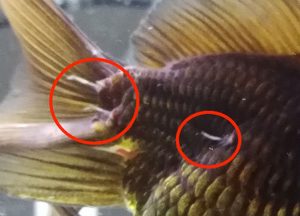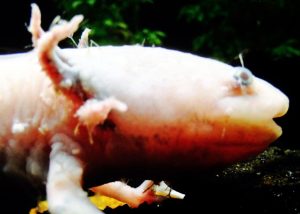Anchor Worms (Lernaea spp.) are not actually worms, but crustacean, copepod parasites of the Lernaea species that attach themselves to the skin of freshwater fish and then bury their head into the muscle tissue usually under the fins, scales, gills, and oral cavity.
Although Anchor Worms can infect any fish species, most tropical fish keeping enthusiasts find them in Koi, goldfish, and other cyprinids housed in larger aquariums and ponds.
Although Lernaea infestations are not necessarily fatal to fish, their burrowing often leads to inflammation, secondary bacterial infections, and fungal diseases that kill the fish. Large numbers of Anchor Worms in copepodid stages can kill smaller fish by damaging their gills and interfering with respiration.
Anchor Worms occur in stagnant and slow moving bodies of water and are most prevalent during the warm summer months. The optimal temperature range for Anchor Worms is between 79 and 83° F. Below 68° F, juveniles are unable to complete their development and below 57° F, the females will not reproduce.
Adult females however, will spend the winter on a fish host and lay her eggs when water temperatures warm up in the spring.
LIFE CYCLE:
Anchor Worms are related to shrimp, lobsters, and crabs and have a multi stage 18 to 25 day life cycle that does not require them to pass through an intermediate host.
Only a fish or amphibian is necessary for them to develop from egg to mature adulthood.
During the various stages of their development, Anchor Worms can live on or off of the host fish.
After a male and female Anchor Worm mate, the male dies and the female bores into the fish’s tissue where it eventually embeds her head into the muscle of the fish. Within 24 hours the female matures into an adult and will start releasing eggs into the surrounding water from a pair of posterior sacs. The eggs hatch within 24 to 36 hours at 77° F. and the life cycle repeats itself.
Newly hatched Lernaea are not parasitic and develop through three different stages in about 4 days. They then molt into the first copepodid stage, become parasitic, and attach themselves to a fish usually on the gills.
Over the next week the Lernaea go through five different copepodid stages but do not permanently embed themselves into the fish’s tissue until the last stage.
In the final stage, the females can embed themselves into the host fish or move on to another fish. The males detach themselves and die.
Female Anchor Worms can produce batches of up to 250 juveniles every two weeks for up to 16 weeks which is why they can quickly infest an aquarium or pond.
PHYSICAL SYMPTOMS:
Fish infected with Anchor Worms will have red and inflamed looking skin. Closer investigation usually reveals a bloody red spot with a white to greenish looking thread protruding from the center, which is the adult female worm.
Because juvenile Anchor Worms are microscopic, there are no outward signs of infestation on the fish but you will notice the fish “flashing” or rubbing itself on the bottom or sides of your pond or aquarium as they try to rid themselves of the parasite.
When seen by the naked eye, the most commonly observed life stage of Lernaea is the adult female which looks like a thin hair or thread that is under an inch in length.
CAUSE:
Anchor Worm “disease” is caused by introducing new fish or aquatic vegetation into an aquarium or pond without being properly quarantined. Fish with juvenile anchor worms or reproductive capable females under their skin will rapidly spread the parasite throughout an aquarium or pond.
TREATMENT:
Adult female Anchor Worms can survive 30 days on a fish host and are much hardier than the younger life stages. If you are going to treat only a few fish, tweezers or forceps can be used to gently remove the visible female Anchor Worms.
To insure that all of the other life stages of the parasite are controlled, additional treatments of the entire system should continue for up to several weeks.
Other treatments available for anchor worms in an aquarium or pond environment include salt dips, formalin dips, and several over the counter antiparasitics like organophosphates, Dipterex, or Anchors Away.
- Potassium permanganate
is generally considered the best treatment and can be used either as a “dip” or a complete pond/tank treatment.
A Potassium Permanganate dip at 100mg/ 2.5 gallons of water will kill the other life stages of the Anchor Worm. Dip the infected fish in the solution for 25 to 30 minutes and remove it if it becomes overly stressed. Transfer the fish into a clean isolation tank and maintain clean fresh water.
If you decide to treat the entire tank add 2 mg of potassium permanganate per liter of aquarium water.
- A 10 to 15 minute dip of 1 part water to 4,000 parts formalin is also effective in killing Anchor Worms. Use with extreme caution.
- Salt is also an effective medication for Anchor Worms if your fish can tolerate it. Use 1 to 2 tablespoons per 5 gallons of tank water and perform water changes every day for 1 week.
Maintain the 1 to 2 tablespoons of dissolved salt ratio in the aquarium for 30 days.
- Dimilin
(diflubenzuron
) marketed as Anchors Away, is an effective treatment for Anchor Worm, Fish Lice, Gill Maggots (Ergasilus), and Flukes. It is less toxic than organophosphates towards fish.
In powder form a 10g to 2,642 gallon solution (25% Diflubenzuron)is a fairly forgiving dose. Although about 76% of the treatment remains after one week, a second treatment 10 to 14 days after the first treatment is needed to remove all stages of Lernaea spp.
(A level teaspoon equals approximately 2g)
- Dipterex
(Trichlorphon) is a water soluable insecticide often used at 98% potency to kill Anchor Worm infestations in ponds. A 1 milliliter to 790 – 1320 gallons of water dose is used three times at 7 day intervals to treat large ponds.
Dipterex breaks down after a few days. The Anchor Worm eggs that survive the initial treatment and emerging parasites are killed by the follow up treatments.
Using any of the above treatments may require follow up treatments for bacterial and fungal infections caused by damage to affected tissue from burrowing Anchor Worms.
PREVENTION:
Isolate and quarantine new fish before introducing them into an existing system. High risk species like Koi and goldfish should be visually screened for adult female Anchor Worms and then monitored for 18 to 25 days during quarantine. If parasites are detected, treat immediately with one of the above mentioned methods and maintain high water quality.
Sterilize the aquarium completely to minimize any re-occurrences.




